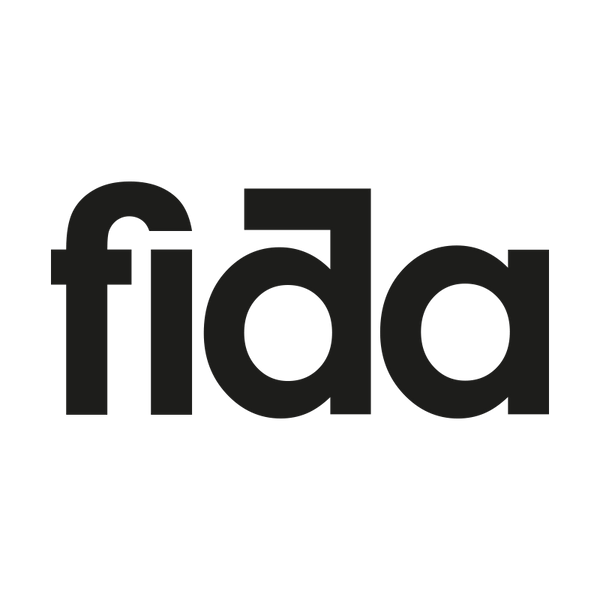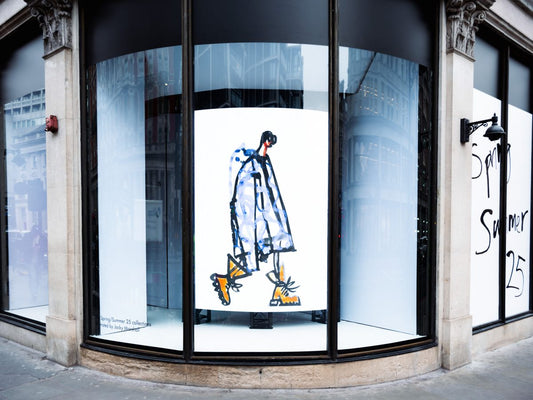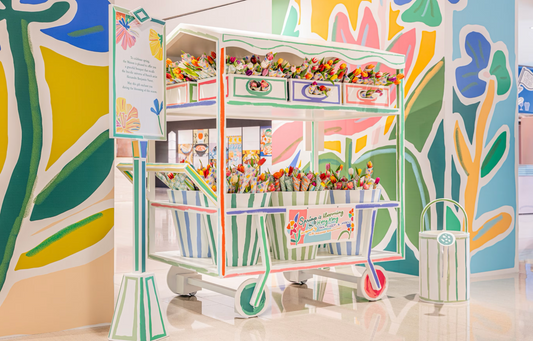
Visual Vocabulary & Diversity in Colour With Adrian Bauer
Share
Adrian Bauer is a German illustrator and art director known for his vibrant, minimalist style that emphasises geometric shapes, bold colours and mesmerising textures. Drawing inspiration from mid-century modern design, Minimal Realism and contemporary illustration, Bauer has crafted a distinct visual language that simplifies complex subjects into easily recognisable, playful forms.
What initially sparked your passion for illustration and storytelling?
I grew up in an artistic family environment. My parents were art teachers and had a studio in our house - pencils, paints and paper were practically always lying around and freely available at any time. There was always something being painted or crafted somewhere. In addition, my love of books, comics and animated series has led me to illustration. I was fascinated by the fact that you could create entire fantasy worlds through drawing — This felt like kind of magic to me.

Can you walk us through your creative process when developing a new illustration? Do you have any specific rituals or techniques that help you get started?
The creative process for illustration is a bit like building a house and I think the first phase of concept creation is almost always the most important. This first phase is very intense. I do a lot of research, create mind maps, find buzzwords, make rough sketches and find moods that create a “look and feel”. This can also be a suitable piece of music, a poem or a film. I collect everything first without any evaluation. This will follow in the next step, when I create a kind of “best-of list” of the ideas that are worth developing further.
The following part is the sketch part where I scribble rough compositions to establish a basic layout. Here I experiment with shapes, perspectives and dynamics. This phase is about letting ideas flow freely without having to worry about precision. Once I'm happy with a composition, I start refining the details. Here I adjust proportions, finalise character or landscape features and create a balanced harmony. Very often at this point I start working in Illustrator to work out the geometric shapes.
After I have defined everything, I first add colour. Up until then everything was mostly just in grayscale. I design and experiment with a palette that matches the emotions of the scene or expand on the company's existing corporate colour palettes. In the final step I go into detailing: here I refine the remaining areas by adding highlights, shadows and textures, mostly in Photoshop. This last step is always extra fun!
I have a variety of playlists for different stages in my work, for example a motivational, a concentration and also a deadline playlist.

How do you approach visual storytelling in your work? What elements do you believe are essential for creating a compelling narrative through your illustrations?
Good storytelling captivates the audience, encourages interaction, and has an impact long after the story is over. With visual communication or visual storytelling it's exactly the same, I don't even need words here. Good illustrators are therefore often good storytellers: They use images and symbolism, colours and compositions to direct and convey emotions and narratives that resonate with audiences. They skilfully combine visual elements to create a cohesive experience that draws the viewer in and makes them feel connected to the story.
As an outdoor enthusiast, how does your connection with nature influence your illustrations and the themes you explore in your work?
Nature offers an endless source of inspiration for me. Its diversity in colour, form, texture, and movement provides a foundational visual vocabulary that artists can draw from endlessly. You can find there unique patterns, colours, and shapes — think of the fractals in snowflakes, the symmetry of leaves, or the gradient colours in a sunset. It's a bit like a huge analog Pinterest archive of inspiration. Being outside in nature is also a source of energy for me: It profoundly influences creative thinking by allowing a break from structured environments, it offers a welcome change from screen-heavy environments with a digital overload. And it has a healing, stress-reducing and meditative effect on me.

What is it about dinosaurs that captivates you the most? Have you ever had the opportunity to incorporate your love of dinosaurs into a commission?
Dinosaurs are a bit like the real-life version of dragons. Even as a child, I was totally fascinated by the subject and instead of learning English vocabulary, I preferred to learn the complicated names of dinosaurs. I still haven't really forgotten these names, they are all stored deep in my brain and I could probably list 20 different dinosaurs in particular at the drop of a hat. Dinosaurs remind us that no matter how dominant or resilient a species might seem, nature's course is unpredictable and every era also has its end. Maybe that’s part of what makes studying them feel so profound: They offer a window into deep time, reminding us of both our fragility and our place in a much larger story. I've had the chance to work on dinosaur-related projects twice so far. Unfortunately, one of them was not realized in the end and the other project was an exhibition for the Wadden Sea National Park, which also included dinosaur themes. But it would be a dream project for me to illustrate a complete dinosaur book or for a dinosaur exhibition.

In what ways has German art and culture shaped your artistic style, and are there particular cultural elements or traditions that you incorporate into your illustrations?
In general, I don't think you can say that my illustrations convey a specific German cultural heritage. German art and design history is too multi-layered for that and, from a historical point of view, is characterised by too many breaks and also appropriations, e.g. by dictatorships. What you perhaps can say, is that design movements such as 'Bauhaus' and the 'Neue Ulmer Schule' have left their mark on design thinking in Germany and still play a role at universities. The love of geometric graphics, concise typography and a clear and sometimes even radical formality are things that are existent. Somehow, we Germans are a bit of clarity and order fetishists, even if that may be changing a bit with the younger generations.
Are there specific artists, authors, or movements that have influenced your style or approach to illustration? How have they shaped your work?
Personally, as an illustrator, I could never really break away from design because I think the boundaries here are fluid. My heart burns for applied illustrations that always have added value and a purpose. For example, I am a big fan of popular scientific illustrations from the 19th century that combine artistic creativity with scientific accuracy. Fritz Kahn comes to my mind here, a pioneering medical illustrator known for his innovative and visually striking diagrams that creatively represented complex biological processes and human anatomy. Stylistic influences certainly also come from Pop Art, Cubism and Minimal Realism. I admire Charley Harper for his special ability to transform complicated natural motifs into simple, striking forms that celebrate the beauty of wildlife and the environment. I really love this kind of visual language!

What has been your most challenging project to date, and what made it particularly difficult for you?
There isn't one project that was the biggest challenge for me, but there have been a few in the past, yes,-). Particularly larger projects that last over a longer period of time and require a lot of coordination loops with a larger team are sometimes a bit challenging in project and communication management. And of course projects that are conceptually demanding, as the preparation of the content requires a greater amount of effort. These are usually complex infographics, large hidden object illustrations or strategy visualisations.

If you could collaborate with any creative from another industry - be it a fashion designer, musician, or filmmaker - who would it be, and what would that project look like?s.
In my experience so far, the greatest ideas and projects come from interdisciplinary collaboration. Thinking outside the box connects completely new synapses and opens up unimagined new possibilities. For example, I would currently find it very exciting to work with product and fashion designers from the sports industry or the outdoor sector. This is certainly also because I can identify emotionally with these products and use them daily for myself. I would be happy to be able to work with sustainably oriented manufacturers in the industry such as Vaude or Patagonia.
What advice would you give to aspiring illustrators and visual storytellers looking to incorporate their passions into their work? How can they find their unique voice?
Developing your own art style is certainly a lifelong, ongoing and never really finished process. That's why I personally always find it difficult to say, yes, that's exactly what it is now and I will do that until the end of my life. To find a unique voice, start by exploring subjects and themes that genuinely inspire you — whether it's history, nature, or personal memories. Don’t be afraid, be hungry for knowledge, be curious, experiment with new techniques, reject and learn to deal with failure. That's totally fine, there's no straightforward blueprint here. Always do what you enjoy, because fun and satisfaction is one of the greatest human intrinsic drives. The more you practice and explore, the more your unique style will emerge! My last Top 3 pieces of advice: Don't sell yourself short, don't take criticism of your work too personally and don't work with a**holes and you will find your way!

Adrian Bauer's work speaks to various audiences, from agencies and advertising firms to publishing houses and corporations, where he effortlessly weaves editorial illustration, information design, and corporate branding together. For his works he has received several awards such as the 3x3 International Illustration Award and the Adobe Government Creativity Award.
See more of Adrian Bauer:
Website: https://adrianbauer.myportfolio.com
Instagram: https://www.instagram.com/studio.adrianbauer (@studio.adrianbauer)
Mail: contact@adrianbauer.net



